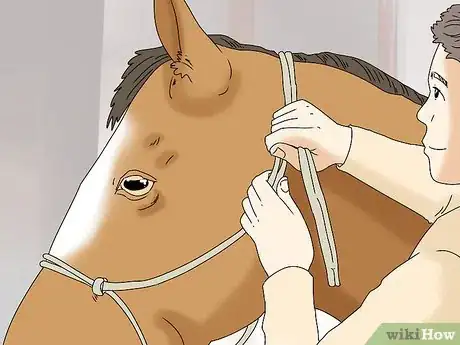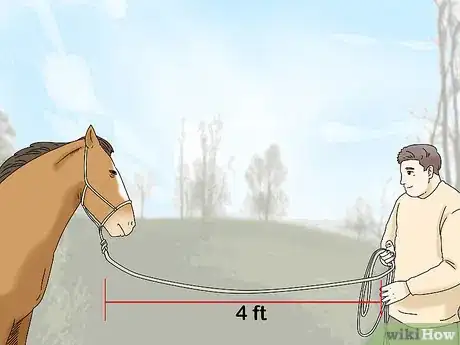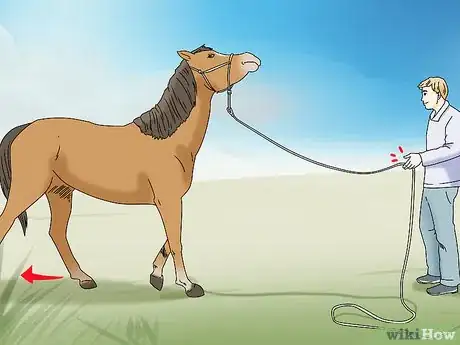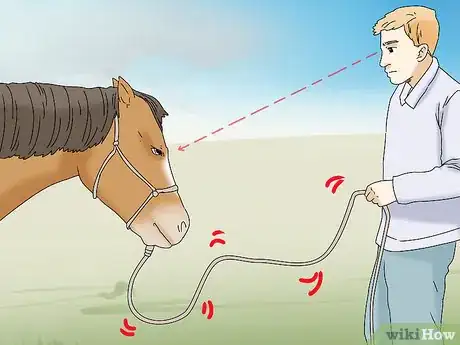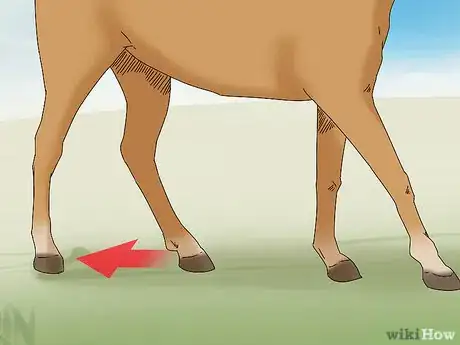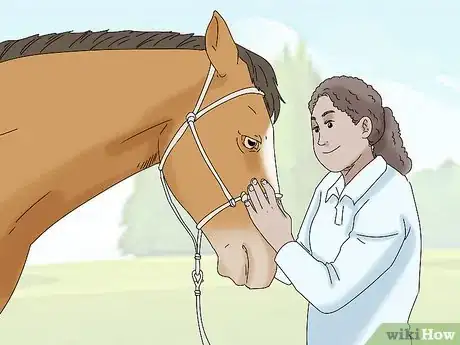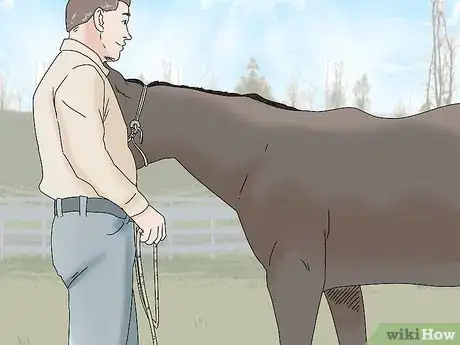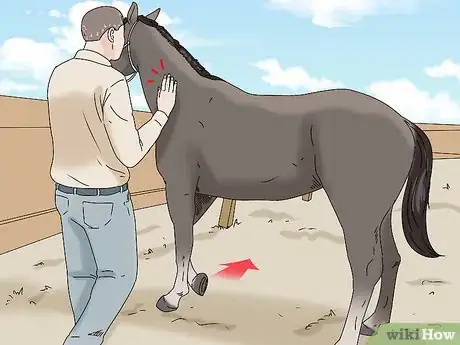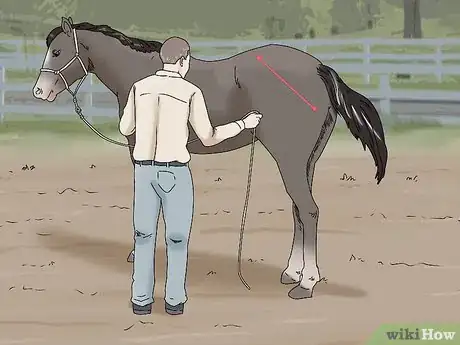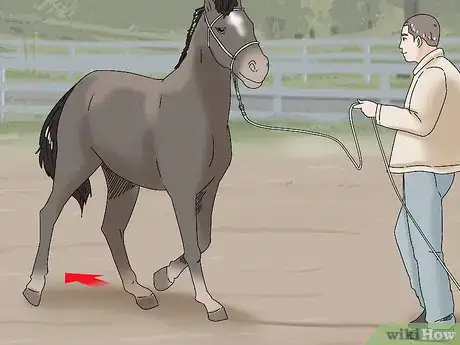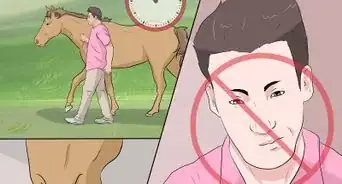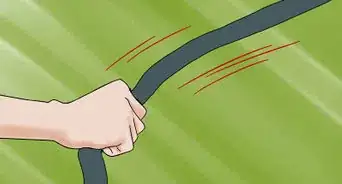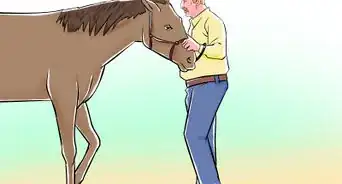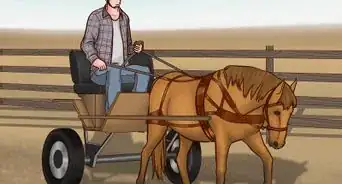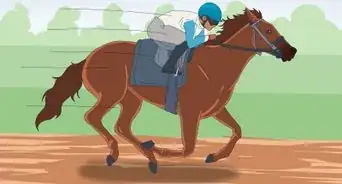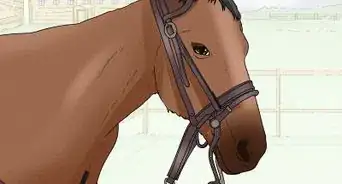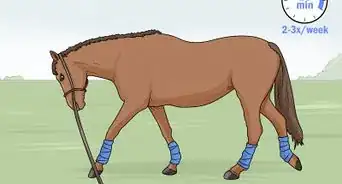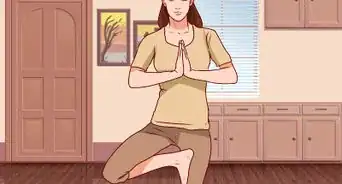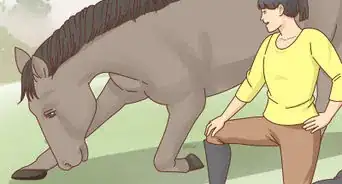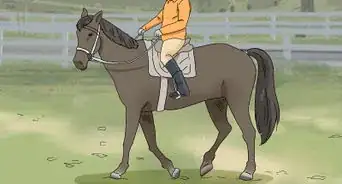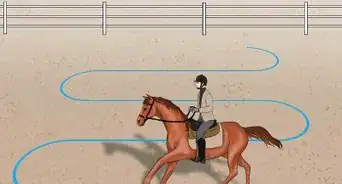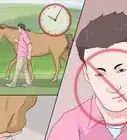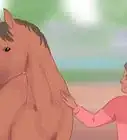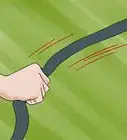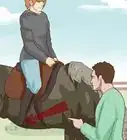This article was co-authored by Ryan Corrigan, LVT, VTS-EVN and by wikiHow staff writer, Amy Bobinger. Ryan Corrigan is a Licensed Veterinary Technician in California. She received her Bachelor of Science in Veterinary Technology from Purdue University in 2010. She is also a Member of the Academy of Equine Veterinary Nursing Technicians since 2011.
There are 14 references cited in this article, which can be found at the bottom of the page.
This article has been viewed 30,219 times.
Teaching a horse to back up, also called backing, is an essential skill that will help it learn to respect your personal space and your role as the herd leader. In addition, being able to successfully back will lay the groundwork for teaching the horse other skills. The easiest way to teach your horse to back is to start from the ground and work with a lead rope. However, you can also use your hands to teach your horse to back up in close quarters, which could come in handy if you don’t have room to work with a rope.
Steps
Backing from a Distance
-
1Fit the horse with a rope halter and attach a 14 ft (4.3 m) lead rope. Approach the horse from the left side, holding the halter in your left hand so the horse can see it clearly. Hold your right hand out so the horse can sniff your scent, then loop your lead line around the back of the horse’s head and slip the harness over its nose and ears. Buckle the halter, then clip on the lead rope.[1]
- If you try to hide the halter while you’re approaching the horse, it will be less likely to trust you.
- Stay slightly to the side of the horse throughout this exercise. It’s dangerous to stand directly in front of a horse, since it won’t be able to see you clearly.
-
2Hold the lead rope about 4 ft (1.2 m) from the clip. When you’re teaching a horse to back up, it’s best not to stand too close. Horses don’t back up much naturally, so they might resist this training a little at first. By giving yourself about 4 ft (1.2 m) of space, you’ll be more likely to be safe if the horse kicks or rears.[2]
- If you’re carrying a clinician’s stick, you can use the stick as a guide for how far back to stay from the horse.
Advertisement -
3Get the horse’s attention, then apply a little pressure to the rope. Call the horse, click your tongue, or wave your hand to get your horse to look at you if it isn’t already. Make sure the horse is looking at you with both of its eyes, which means it’s giving you its full attention. Once it is, gently pull back on the lead rope to take the slack out.[3]
- Don’t pull hard enough that the horse starts to balk. Just pull the line tight so there’s no slack and you’re sure the horse can feel the pressure.
- If you’re having trouble getting the horse’s attention, give the rope one firm shake. This is known as “bumping the rope” and will often cause the horse to look at you.[4]
-
4Shake the rope gently from side to side while maintaining pressure. Starting with as gentle a movement as you can, shake the rope from side to side until the movement travels all the way up the rope. If the horse doesn’t respond after a few seconds, shake the rope a little harder.[5]
- Working the rope from side to side will make the horse want to move its feet, and the forward pressure on the rope should encourage it to step backward.
- It’s unlikely that the horse will respond to a light shake at first, but you should always start this exercise as gently as possible. That way, the horse can eventually learn to respond to a light cue. You can escalate as needed, but if you start too strong, the horse will expect that level of energy each time. [6]
Tip: Experiment with different techniques, including tapping the rope with a clinician’s stick, wiggling the stick in front of the horse, or even waving your hands to drive the horse backward.
-
5Lighten your grip on the rope immediately when the horse steps back. When you’re starting out on this training exercise, reward the horse for even the slightest backward motion. It’s important to build a foundation where the horse understands what you expect. The moment you see the horse move its feet backward, let some of the slack back into the lead rope. Don’t let go of the rope entirely, but hold it loosely so the horse feels the pressure release.[7]
- It’s the release of pressure that acts as a reward for the horse when it steps backward. If you don’t immediately reward the horse, it won’t know that it did the right thing, so it will be less likely to repeat that behavior.
- It's okay if the horse keeps backing up even after you lighten the pressure on the rope. In most cases, the horse will stop doing this once it becomes more familiar with the training. If it continues, however, you might need to work the horse a little harder so it looks forward to the chance to take a break.[8]
-
6Give the horse a stern look and shake the rope harder if it doesn’t back up. If the horse doesn’t back up within a few moments, change your facial expression so you’re giving it a stern, authoritative look. Then, shake the rope more vigorously, stepping toward the horse if you need to. This gradual escalation will let the horse know that you’re still looking for a certain behavior.[9]
- If the horse still doesn’t back up, you might even need to gently tap it with your stick in the center of its chest.
- As another option, place your palm in your horse's shoulder groove and apply firm pressure. Most horses will immediately back up when you do this.
- Never hit your horse to punish it. This will destroy the trust relationship between you and the horse, and it could cause it to have problems with disrespect and aggression in the future.
-
7Increase your expectations gradually. As the horse begins to understand what you want, start asking it to be consistent, then to add more energy into its feet. For instance, at first, you might reward the horse for taking a single shuffling step backward, but by the end of the session, you might only release the pressure on the rope when the horse takes 2 good steps back.[10]
- Once the horse consistently takes several steps during each exercise, focus on how it moves its feet. You might not reward the horse, for instance, for dragging its feet on the ground, but instead, keep the pressure on the rope until it lifts its feet with each step.
-
8Approach the horse and touch its face once it stops moving. Each time you perform the exercise, stroke the horse on the face. This will help desensitize the horse, and it will also strengthen the bond between the 2 of you.[11]
- If you’re using a stick, you can also stroke the horse's face with the stick. This will help the horse be less afraid of the stick. You want the horse to follow your directions willingly, not out of fear.
-
9Continue practicing each day for about 10-20 minutes at a time. You’ll see better results in training your horse if you do groundwork exercises every day. If the horse seems very comfortable backing up, you don’t necessarily have to devote all of your groundwork time to backing. However, this is a skill that will act as a building block for other exercises, so it’s important to spend time making sure your horse can back well.
- Even after you’ve moved on to other training exercises, continue to work on backing a few times a week.
- With enough practice, you should be able to get the horse to back just by shaking the lead rope, no matter where you are.
Backing up in Close Quarters
-
1Stand close to the horse, but slightly off to the side. Hold the lead rope in your right hand and stand slightly to the left of the horse’s head. Standing to the side of the horse is less dangerous than standing directly in front of it, because the horse will be able to see you better. It will also be harder for the horse to kick you if it gets upset.[12]
- If you ever find yourself in a situation where you need the horse to back up but you don’t have room to wiggle the lead rope, this exercise will be useful.
-
2Tap the horse on the side to get it to step sideways. Lightly push or tap the horse on one side of its hind end, and continue until the horse takes a step sideways. This is called “disengaging the horse’s hindquarters,” and it helps the horse feel more inclined to move around.[13]
- Some horses will balk if you try to get them to back up. By disengaging its hindquarters first, you’re putting energy into its feet. This can help keep the horse from getting stuck or refusing to move.
-
3Pull the lead rope back and to the side. With light pressure, pull the lead rope back toward the horse’s hindquarters. Depending on how the horse moved when you disengaged its hindquarters, you can pull the rope toward whichever side is more convenient. Apply light, steady pressure, gently increasing the tension in the rope until the horse steps backward.[14]
- Start off by only expecting 1-2 good backward steps.
Tip: At first, you may end up pulling hard on the rope. However, always start gently, since you want the horse to learn to respond to the lightest pressure possible.
-
4Release the pressure as soon as the horse steps backward. As soon as you see the horse take a step backward, it’s important to reward its behavior. The way you show the horse that it’s done a good job is to lighten the tension in the lead rope.
- If you’re pulling toward the horse’s hind end, relaxing your arm and moving your hand toward the horse’s head should release the tension in the rope.
-
5Pet the horse's head and hind end to desensitize it. Horses are very sensitive to touch. If you’re using physical cues to train it, it can sometimes help to stroke or rub the horse afterward to help it relax. First, stroke the horse on its nose, then reach back and pat it on the hindquarters.[15]
- This also helps the horse know that it’s doing a good job.
Things You’ll Need
- Halter
- Lead rope
- Horse
References
- ↑ https://www.equisearch.com/articles/safe-haltering-and-tying
- ↑ https://youtu.be/2R0ROmN_kVA?t=73
- ↑ https://youtu.be/2R0ROmN_kVA?t=73
- ↑ https://horseandrider.com/trail-riding/backing-basics-with-clinton-anderson-16922
- ↑ https://youtu.be/z5nsLzPMxI0?t=59
- ↑ https://youtu.be/qhP49AtUmio?t=58
- ↑ https://youtu.be/2R0ROmN_kVA?t=89
- ↑ https://youtu.be/2R0ROmN_kVA?t=105
- ↑ https://youtu.be/qhP49AtUmio?t=93
- ↑ https://horseandrider.com/trail-riding/backing-basics-with-clinton-anderson-16922
- ↑ https://youtu.be/2R0ROmN_kVA?t=94
- ↑ https://horseandrider.com/training/backtrack-15884
- ↑ https://youtu.be/2R0ROmN_kVA?t=369
- ↑ https://youtu.be/2R0ROmN_kVA?t=388
- ↑ https://youtu.be/2R0ROmN_kVA?t=411
- ↑ https://youtu.be/qhP49AtUmio?t=261
